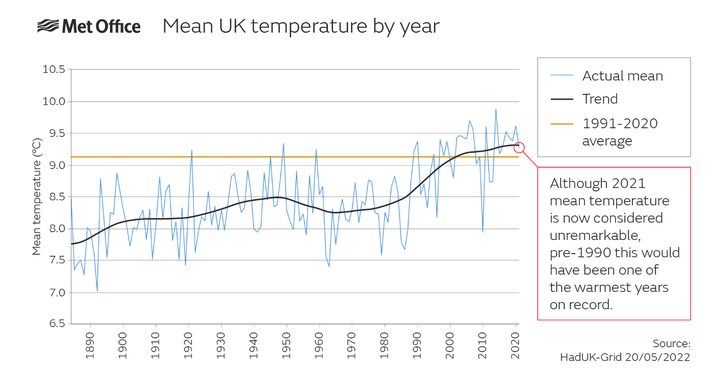Compared to July’s heatwave – which saw fires erupt across London – 2021 weather seemed positively mild.
However, the Met Office’s State of the Climate report, released a week after UK temperatures reached a record-breaking 40.3C, says otherwise.
The weather experts assessed the 2021 climate, including extremely destructive events like Storm Arwen, sea levels and, of course, the heat.
It found that while last year’s climate seemed “unremarkable” by today’s standards, just 30 years ago, Brits would have found it exceptional.
According to the Met Office, if 2021′s temperatures were recorded in 1992, it would have been one of the UK’s warmest years on record.
What’s happened?
The temperature has increased year-on-year. While it may seem like only marginal changes, it is actually a huge difference.
The report shows that last year’s average temperatures were just 0.1C above the average for the period 1991-2020, with 2021 the 18th warmest on record in a data series stretching back to 1884.
But most of those 18 warmest years have occurred since the turn of the century, and if 2021’s temperatures had occurred before 1990 it would have been the second warmest year on record, the Met Office said.
The most recent decade, from 2012 to 2021, has been 1C warmer than the period 1961-1990, the peer-reviewed report published in the Royal Meteorological Society’s International Journal of Climatology shows.

The knock-on effects
This changing climate has altered the seasons, meaning crops came at different times of year, as September and October were warmer than average in 2021.
Animals are not evolving at a fast enough rate, meaning they are struggling to find new habitats to thrive in.
Of course, it wasn’t all exceptionally hot. There were surprisingly cold temperatures in April which delayed certain species coming to bloom.
Sea levels are rising faster than they were a century ago. Since 1900, they have risen by around 16.5cm – but the rate of the increase is rising exponentially. In fact, all of the UK’s top warmest years (from 1884) have occurred since 2000.
The experts point out that there is now an increase of 3-5.2mm a year – more than double the increase rate seen during the first few decades of the 1900s.
The rising sea levels mean an increase in storm surges and wind, damaging both the environment and homes.
A handful of UK regions will be seriously under threat, according to early predictions. By 2054, experts believe the low-lying town of Fairbourne will no longer be able to keep up flood defences there because of faster sea level rises and more frequent and extreme storms caused by climate change.
In total, around half a million homes in the UK will be at risk from flooding.
Why has it changed so much?
The planet has warmed by around 1.1C in the last two centuries, due to the greenhouse gases released into the atmosphere.
Mike Kendon from the Met Office National Climate Information Centre said: “Although 1C of warming might not sound like much, it has led to maximum temperatures like the 32.2C we saw in 2021 becoming routine rather than the exception.
“This is particularly stark when considering the record-breaking heat the UK experienced just last week.”
The UK is also warming slightly faster than the average global temperature.

